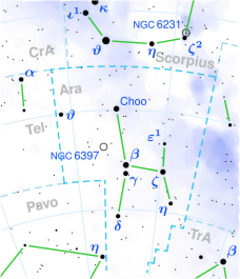Astronomy:Lambda Arae
| Observation data Equinox J2000.0]] (ICRS) | |
|---|---|
| Constellation | Ara |
| Right ascension | 17h 40m 23.82558s[1] |
| Declination | −49° 24′ 56.0993″[1] |
| Apparent magnitude (V) | 4.77[2] |
| Characteristics | |
| Spectral type | F4 V[3] |
| U−B color index | −0.04[2] |
| B−V color index | +0.40[2] |
| R−I color index | +0.22 |
| Variable type | 3.10[4] |
| Astrometry | |
| Radial velocity (Rv) | +3.6[4] km/s |
| Proper motion (μ) | RA: +104.233[1] mas/yr Dec.: −175.956[1] mas/yr |
| Parallax (π) | 47.7045 ± 0.1368[1] mas |
| Distance | 68.4 ± 0.2 ly (20.96 ± 0.06 pc) |
| Absolute magnitude (MV) | +3.06[5] |
| Details | |
| Mass | 1.4[1] M☉ |
| Radius | 1.7[1] R☉ |
| Luminosity | 4.7[1] L☉ |
| Surface gravity (log g) | 4.06[1] cgs |
| Temperature | 6,495[1] K |
| Metallicity [Fe/H] | −0.24[4] dex |
| Rotational velocity (v sin i) | 15.5[6] km/s |
| Age | 2.4[1] Gyr |
| Other designations | |
| Database references | |
| SIMBAD | data |
Lambda Arae (λ Ara, λ Arae) is the Bayer designation for a star in the southern constellation of Ara. It is at a distance of 68 light-years (21 parsecs) from Earth. The apparent visual magnitude of this star is 4.77,[2] making it bright enough to be seen with the naked eye.
The spectrum of this star matches a stellar classification of F4 V,[3] which places it among the category of F-type main sequence stars. It shines with 4.7 times the luminosity of the Sun. The outer atmosphere is radiating this energy at an effective temperature of 6,495 K, giving it the yellow-white hue of an F-type star. There is some evidence that this may be a binary star system consisting of two stars with identical masses.[6]
Examination of Lambda Arae with the Spitzer Space Telescope shows an excess of infrared emission at a wavelength of 70 μm. This suggests it may be orbited by a disk of dust at a radius of more than 15 astronomical units[8]
References
- ↑ Jump up to: 1.00 1.01 1.02 1.03 1.04 1.05 1.06 1.07 1.08 1.09 1.10 Vallenari, A. et al. (2022). "Gaia Data Release 3. Summary of the content and survey properties". Astronomy & Astrophysics. doi:10.1051/0004-6361/202243940 Gaia DR3 record for this source at VizieR.
- ↑ Jump up to: 2.0 2.1 2.2 2.3 Johnson, H. L. et al. (1966), "UBVRIJKL photometry of the bright stars", Communications of the Lunar and Planetary Laboratory 4 (99): 99, Bibcode: 1966CoLPL...4...99J.
- ↑ Jump up to: 3.0 3.1 Gray, R. O. et al. (July 2006), "Contributions to the Nearby Stars (NStars) Project: spectroscopy of stars earlier than M0 within 40 pc-The Southern Sample", The Astronomical Journal 132 (1): 161–170, doi:10.1086/504637, Bibcode: 2006AJ....132..161G.
- ↑ Jump up to: 4.0 4.1 4.2 Holmberg, J.; Nordstrom, B.; Andersen, J. (July 2009), "The Geneva-Copenhagen survey of the solar neighbourhood. III. Improved distances, ages, and kinematics", Astronomy and Astrophysics 501 (3): 941–947, doi:10.1051/0004-6361/200811191, Bibcode: 2009A&A...501..941H.
- ↑ Ammler-von Eiff, Matthias; Reiners, Ansgar (June 2012), "New measurements of rotation and differential rotation in A-F stars: are there two populations of differentially rotating stars?", Astronomy & Astrophysics 542: A116, doi:10.1051/0004-6361/201118724, Bibcode: 2012A&A...542A.116A.
- ↑ Jump up to: 6.0 6.1 Fuhrmann, K. et al. (August 2011), "Evidence for the nearby F4V star λ Ara as a binary system", Monthly Notices of the Royal Astronomical Society 415 (2): 1240–1243, doi:10.1111/j.1365-2966.2011.18764.x, Bibcode: 2011MNRAS.415.1240F.
- ↑ "lam Ara". SIMBAD. Centre de données astronomiques de Strasbourg. http://simbad.u-strasbg.fr/simbad/sim-basic?Ident=lam+Ara.
- ↑ Lawler, S. M. et al. (November 2009), "Explorations Beyond the Snow Line: Spitzer/IRS Spectra of Debris Disks Around Solar-type Stars", The Astrophysical Journal 705 (1): 89–111, doi:10.1088/0004-637X/705/1/89, Bibcode: 2009ApJ...705...89L.
External links
 |


